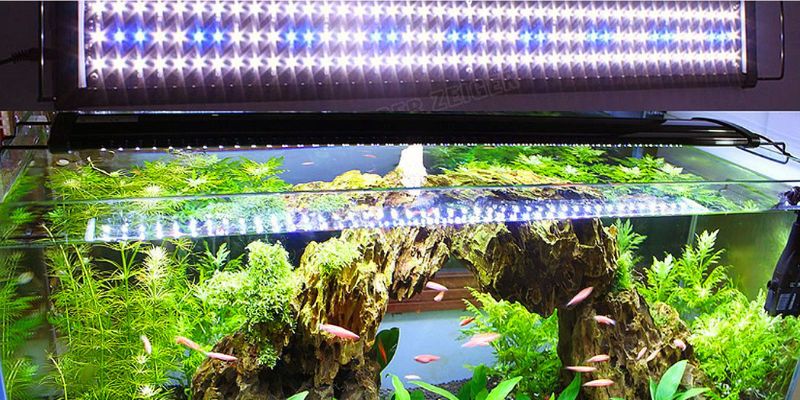Several important considerations must be made before beginning the process of building up a fish tank. The importance of having adequate illumination for your aquatic pets cannot be overstated. This article will dig into “What Are the Proper Lighting Requirements for a Fish Tank?”, examining many elements such as proper lighting requirements, the length of time it is on, the strength of the light, and the benefits it offers to the fish and the overall aesthetics of your tank.
The Value of Proper Lighting
The aquarium’s fish will thrive and flourish under the right lighting conditions. It helps the tank seem better, encourages plant development, and simulates the natural day/night cycle for the fish. By learning how much light your fish tank needs, you can make it a healthier place for your fish to live.
What Are the Proper Lighting Requirements for a Fish Tank?
Traditional Incandescent Lamps
Common aquarium lighting options include incandescent lights. Though they aren’t the worst idea, they aren’t the best one for keeping a healthy aquatic ecology. The intense heat and narrow spectrum of light produced by incandescent bulbs promotes algae growth and is harmful to the fish.
The Use of Fluorescent Lights
The energy economy and adaptability of fluorescent lighting make it a popular option among fish tank lovers. You may adjust the mood of your aquarium to your liking with the help of these lights, which come in a wide range of hues and wattages. In addition, the fish and the plants can benefit from the larger spectrum of light provided by fluorescent bulbs.
Third, Light-Emitting Diode Lighting
LED (Light Emitting Diode) illumination has become increasingly commonplace in aquariums in recent years. LED bulbs last a long time, require little maintenance, and come in a rainbow of colors. They generate less heat, therefore the tank’s contents are less likely to boil. With the right intensity and spectrum, LED lighting is ideal for freshwater and saltwater aquariums.
Things to Think About
-
Light On/Off Cycle Time
Consistent illumination is essential to the well-being of your fish and the balance of the aquarium ecosystem. Most aquarium fish need to be exposed to light for 8-12 hours every day. Lighting must be programmed to switch on and off at certain times to mimic the natural day/night cycle. A timer can be used to automate this procedure and keep the lighting at a constant level.
2.Luminous Intensity
Many fish species prefer dim lighting while others need bright illumination. Learn the lighting requirements of your new fish before adding them to the tank. Some fish, such as those that live in shady areas, prefer low-level lighting, while others, such as reef-dwelling species, need bright illumination for photosynthesis and coral development. Finding that sweet spot is essential for maintaining a vibrant aquatic ecosystem.
Lighting Enhancement for Plants
If you want your aquarium plants to thrive, you need to make sure they get plenty of light. In order to photosynthesize, many aquatic plants need exposure to light intensities between moderate and high. Plant development can be maximized and algae buildup avoided by using full-spectrum bulbs or specialist plant lights.
Benefits of Proper Lighting
Behavior and Fish Health
The health and demeanor of fish are greatly improved by adequate lighting. Adequate lighting encourages natural activities like feeding and resting by synchronizing their internal clocks. It also makes their colors pop more, so they’re more pleasing to the eye.
Phytosynthesis and the Generation of Oxygen
Tanks containing living plants require adequate sunlight for photosynthesis and growth. The presence of thriving vegetation mitigates problems associated with poor water quality and excessive algal bloom. In addition, fish and humans alike benefit from a more natural and aesthetically pleasant setting when abundant aquatic vegetation is present.
Appeal to the Senses
With the right lighting, even the most mundane fish tank can become a fascinating underwater show. Stunning visual effects and the enhancement of your aquatic habitat’s natural beauty are possible with the careful manipulation of lighting. It lets you put the spotlight where you want it, cast shadows where you want them, and create depth, turning your fish tank into a showpiece for your home or workplace.
Conclusion
In conclusion, the health of your fish, the development of your live plants, and the beauty of your aquarium all depend on your knowledge of the aquarium’s lighting needs. You may make a pleasant environment for your fish and yourself by carefully planning the lighting, duration, intensity, and supplementary lighting for plants.
It is important to learn how much light each kind of fish requires and to adjust the aquarium’s lighting properly. The right lighting may transform a pool into a magical underwater kingdom that will fascinate any viewer.


I am in truth happy to gleam at this blog posts which consists of tons of of use facts, thanks towards providing such data.